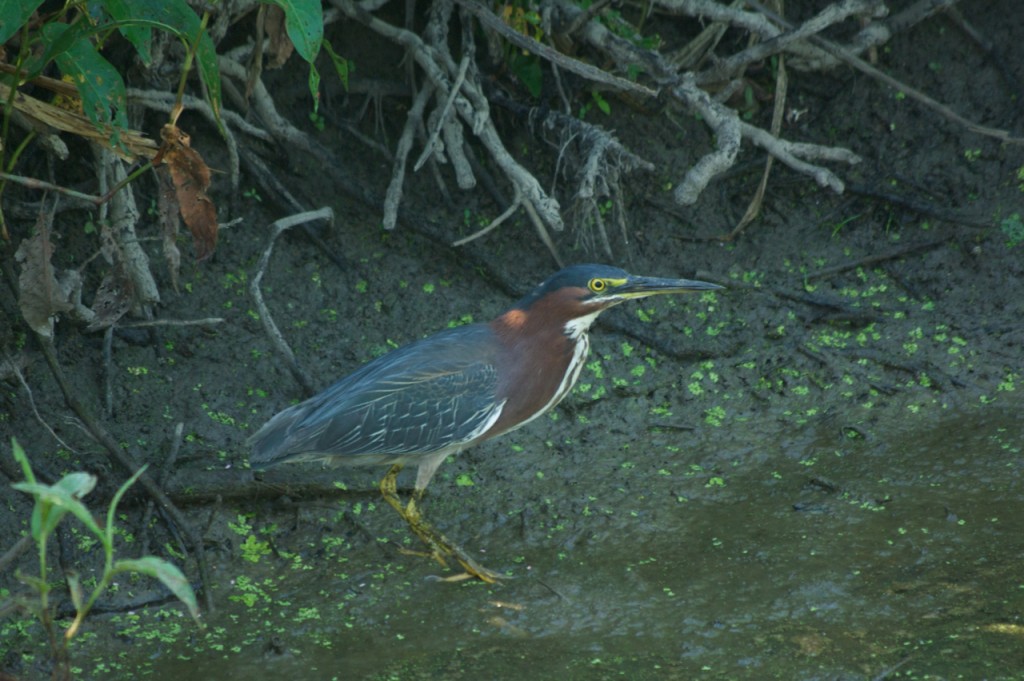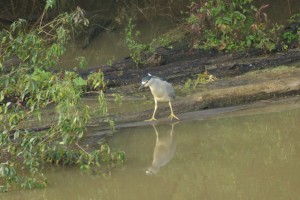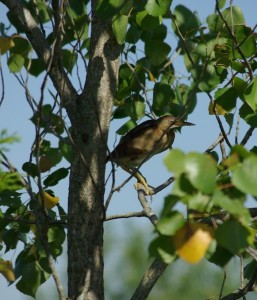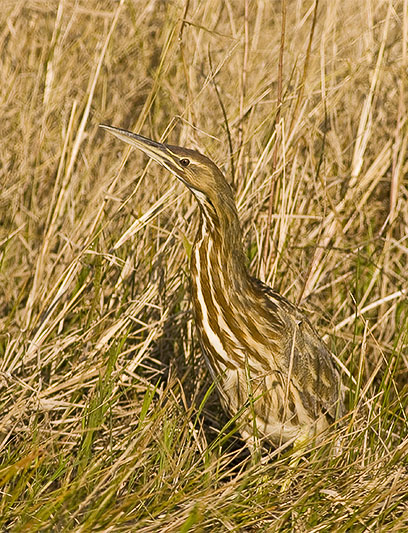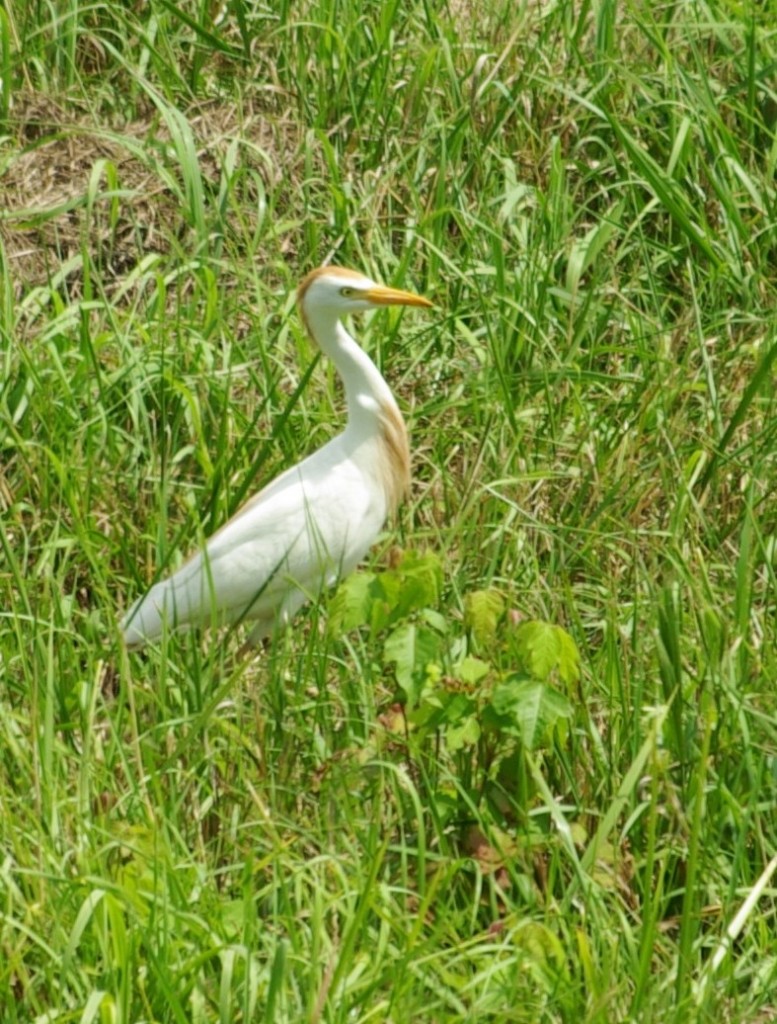The Waders of August, Part 2: Lesser Known Members of the Heron Family
By August flocks of herons and egrets can be spotted at ponds and wetlands, along waterways, and even field drainage ditches. The often seen and graceful “fish cranes” and “white fish cranes” – Great Blue Herons and Great Egrets – are among the common wading birds we see. Lesser know members of the heron family, Ardeidae, also spend time in our area and, in August, some of them often become as visible as their more well known relatives.
Green herons (Butorides virescens) are generally solitary birds and often are quite secretive, particularly while nesting. Their common name has varied over the years, including “little green” and “green-backed,” even though the insistent inclusion of “green” in the name bears little actual resemblance to the bird, for the greenish shading on their back and wings is often not a notable feature.
Small and stocky, green herons reach 18 inches in length with a wingspan of about two feet. Their habit of tucking their neck back often makes them appear smaller than they actually are. The dark gray-green feathers of their head, back and wings are livened by chestnut-colored feathers on the sides of the head and neck, and white feathers along the chin, throat and underside of the neck. The males and females look alike and, in breeding season, rather than the showy plumes of many herons and egrets, green herons make do with only a color change to their feet and legs, from dull yellow to bright orange.
They can be found in nearly any watery habitat, but prefer small ponds with trees, shrubs and healthy vegetation along the borders. Many sinkhole ponds in our upland areas, as well as wetlands along the American Bottoms, host green herons throughout the summer.
Almost unique among North American birds, green herons, along with a few other animals including humans, are tool-users. They will drop a feather, or a leaf or small twig, even a bit of bread (perhaps lifted from the discarded remains of a less-successful fisherman), into water and watch and wait. Any fish that swims over to investigate the bait soon becomes lunch for the green heron.
Seen even less often than green herons are the two species of night-herons that spend summer here. As their name implies, both species are far more active during nighttime hours, though they may forage for food during the day, especially when they have hungry nestlings to feed.
Both the Black-Crowned Night-Heron (Nycticorax nycticorax) and Yellow-Crowned Night Heron (Nyctanassa violacea) are stocky, even chunky in appearance. True to the name, black-crowns have black feathering on their upper heads and down the back, with gray wings and a white face, breast and belly. They sport two or three white plumes from the back of the head which, during breeding season, become longer and more extravagant. Yellow-crowns are grayish overall with bright white cheek patches on their mostly black heads. Their pale yellow crown feathering is adorned with a few long buffy plumes in all seasons.
While both species of night-herons forage in and around wetlands for food, yellow-crowns are more exclusive in their diet, eating mostly crabs and crayfish. Black-crowns tend to eat more fish, but also forage for crayfish, frogs, snakes, and even carrion.
Perhaps most secretive of all the heron family members that come to our area are the two bittern species. Simply because they are so secretive and difficult to spot, Least Bitterns (Ixobrychus exilis) often are at the top of birders’ “most wanted” lists.
The world’s smallest heron, leasts average 13 inches in length with a 17-inch wingspan. Bright buff-colored wing patches contrast with overall dark upperparts; the underparts are pale with buffy streaks. The wings, back, head and tail of male least bitterns are glossy black, while females are dark brown.
Unlike other heron species that forage by wading or waiting along wetland margins or in open water, least bitterns clamber about in dense vegetation within marsh and wetland areas. As it climbs through and around reeds, cattails, bulrush and other marsh thickets, a least bittern looks for small fish and insects as large as dragonflies; food is captured with a quick stab of the long bill.
Least bitterns occasionally will flush and fly when disturbed but more commonly will raise their head with their bill straight upward and then freeze in place, relying on its darkish coloring and utter stillness to keep concealed within dense vegetation. Nestling least bitterns as young as three to four days post hatching are known to take up this alarm pose.
In our area least bitterns spend the summer and breed in areas that meet their need for wetlands with dense vegetation. While they are rarely seen their dawn, dusk and nighttime calls – various “haws” and “tut-tut-tut” sounds can indicate their presence.
The song of the American Bittern (Botaurus lentiginosus) is so distinctive and so unmistakable that identification by voice is the easiest way to discover this species. The song is often described as “broken plumbing” for the “oonk-ka-klunk” sound does have a water-pumping quality. American bitterns visit our area during spring and fall migration but breed to the north. In fall, birds occasionally can be flushed and thus seen around wetland areas and marshes very early in the morning or, again, at nightfall.
American bitterns are handsome birds with a largely rich brown coloration. The underparts are buffy and streaked with dark brown; the brown upperparts are flecked with black. In flight, the trailing wing edges are much darker brown. The 28” inch long bird has a 42” wingspan. Like least bitterns, American bitterns also point their bills skyward and freeze in place when alarmed.
One additional smaller heron visits our area and in most respects differs from the Green Heron, the night-herons and the bitterns. Cattle Egrets (Bubulcis ibis) are not secretive and often are seen; unlike all other herons they spend most of their time away from wetland areas.
The pure white birds are 20” long and have a three-foot wingspan. During breeding season both males and females get buffy-to-orange puffs of plumes on the crown, nape, lower back and foreneck; the normally yellow stocky bill and black feet and legs also turn a bright red during breeding time. While cattle egrets nest near water, often mixing in with other heron and egrets in mixed rookeries, they spend most of their time foraging far from water.
As the name implies these egrets often associate with cattle and forage among herds taking advantage of and gobbling up any insects disturbed by cattle. They occasionally will even perch on a cow and peck at and pick off insects. They also take advantage of humans’ ability to disturb insects and will follow along after tractors or other heavy equipment and, even, lawnmowers. Cattle egrets could also be called “elephant egrets,” or gazelle, camel, or zebra egrets, because in their original home range they forage amongst those herding animals.
Cattle egrets are relatively new emigrants to the New World, with their first appearance recorded in the 1930s in the West Indies after they crossed the Atlantic from their native African homeland. They were first spotted in Florida in 1941 and, by the 1970s and ‘80s were found through much of North America. They are a common sight each summer in our area, with flocks of several hundred birds sometimes seen.
But, with the fading of August and the waning of summer, the cattle egrets, night-herons, bitterns and green herons, along with their much larger and more familiar relatives, will begin to leave our area and retreat away from the threat of winter cold.
Clifftop, a local nonprofit organization, is focused on preserving and protecting area bluff lands.
A version of this article appeared in the June 4th 2010 edition of the Monroe County Independent.
© 2010 all content rights reserved, Clifftop NFP.
Comments are currently closed.

